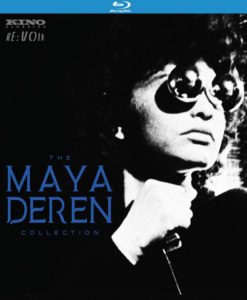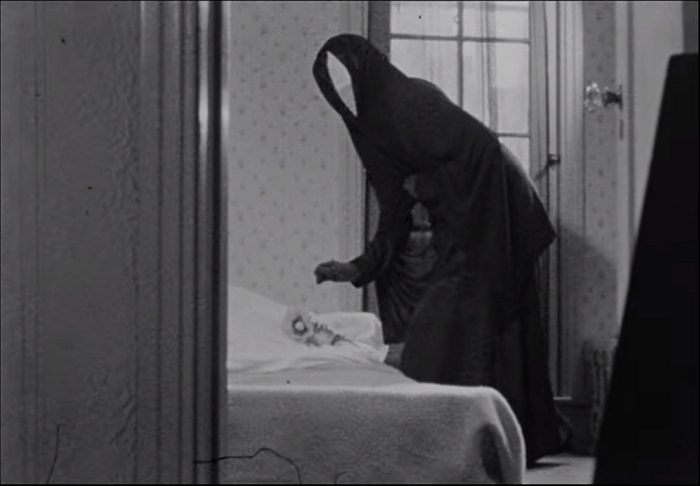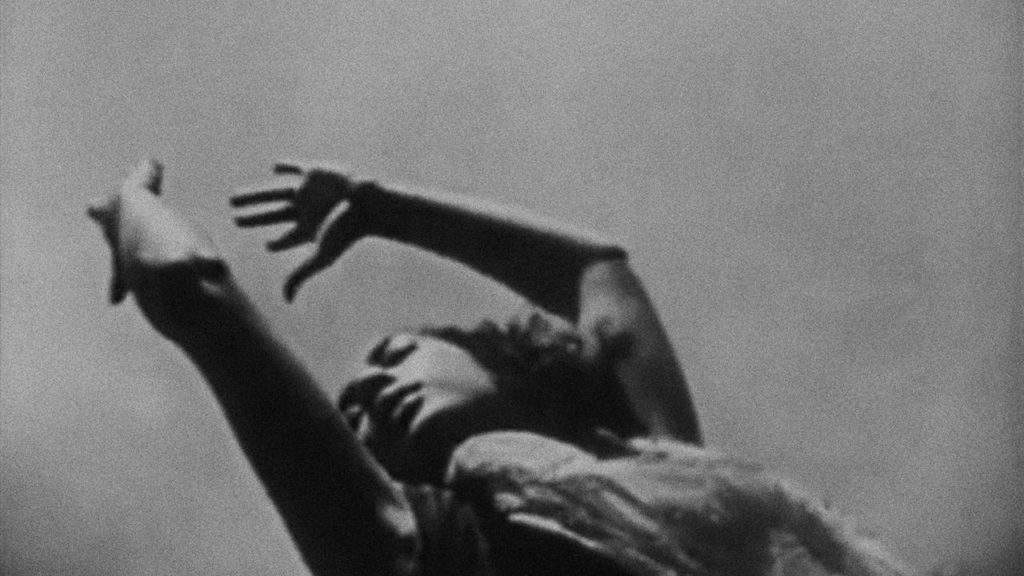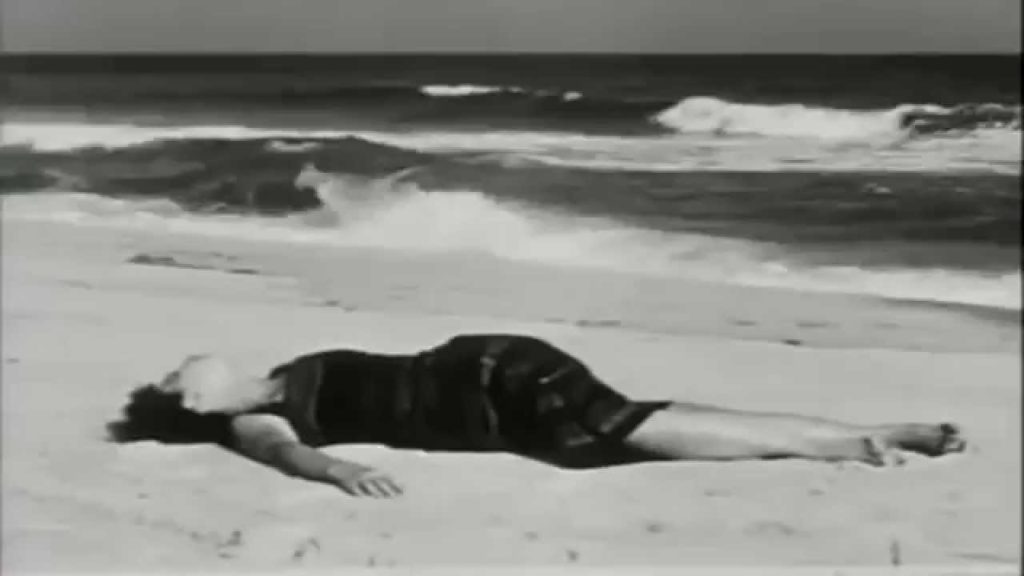Avant-Garde Set Gets to the Insatiable Heart of an Influential Filmmaker.
BLU-RAY STREET DATE: FEBRUARY 25, 2020/KINO CLASSICS

She’s been credited with singularly launching second great wave of the filmmaking avant-garde. Second wave feminists would claim her as a boundaries-defying pioneer. Film students and historians would understand her to be one of the great outspoken intellectuals of the craft. But Maya Deren (born Eleonora Derenkowska, in the Ukraine), beyond all the well-earned hyperbole and deserved credit, was quite set in her ways – as both an artist and a woman.
Which is isn’t to say that she didn’t live life on her own terms. She most certainly did. Nor is it to say that she adhered to the cultural expectations of women of her time. She most certainly did not. But when and where she found her niches – and there were several – she abided by her own unwavering internal logic, and would argue her points articulately, if need be. As her filmmaking continued through the years- always makeshift, always exhibiting do-it-yourself energy and ingenuity- she became increasingly untethered from traditional directorial methodology.
*****
Her first such film, and her most famous (deservedly so?) is 1943’s uneasy daydream, Meshes of the Afternoon. It’s overt use of symbols cannot be gotten around: A key. A knife. A beautiful flower. As an enigmatic everywoman (Deren herself) dressed in black makes her way around an outdoor pathway, she encounters a strange, cloaked figure. Beyond its foreboding reaper-like hood, we see that it has a mirror in lieu of a face. This figure comes and goes through the remainder of the film. Deren, however, persists into the house, then up the steps. There’s no dialogue, but there is atonal musical tinking, which sometimes syncs with the action, but just as readily, does not. Finally, it feels like something of a murder mystery; an oneiric wandering into an unknown property of proto-feminism and direct symbolism. Sharing credit with her then-husband (her second), filmmaker Alexander Hammid, and utilizing compellingly atonal original music by Teiji Ito (who would go on to contribute all her musical scores, as well as become her final husband), Meshes earns its acclaimed standing in cinephile circles.

In the intentionally completely silent short At Land, Deren emerges from the unsettled sea on an isolated beach onto a long table in an ornate dining room. The fact that everyone seated at the crowded table completely ignores her isn’t necessarily surprising, considering that they initially seem to be cigar chopping wealthy men. But as she claws her way to the other end, we see that many of the occupants are also smiling women, they too happily oblivious of her. Somehow, this just makes it worse. Her journey continues as she returns outdoors to desolate terrain. Eventually, it all leads to two more unknown laughing women playing chess on a pebbled beach. Did Ingmar Bergman see this film before he made The Seventh Seal? From the blocking to the framing to the tenor itself, the similarities are remarkable.
Another standout film in this single-disc set is Ritual in Transfigured Time. This fifteen-minute work bears not only the headiest title, but evidences Deren’s boldest steps as a filmmaker. Another thoroughly silent endeavor, she is by this point emboldened enough in her craft to attempt some anti-natural techniques such as slow motion and freeze-framing. In so doing, she visually explores the surreal quality of the “momentous occasion”: wedding receptions, funeral gatherings, et cetra. According to Deren herself, the piece is a formal dwelling in which “a widow becomes a bride”. Again, she herself takes center stage, physically traversing her way through the sensory-assaulting and often condescending nature of poetically steered emotion.
The Very Eye of Night, completed in 1955, sees Deren at a creative, non-narrative apex of her creative interests. Choreography, dance, filmmaking and the cosmos converge for this fifteen-minute cinematic soirée, utilizing a skilled troupe, a makeshift starfield, and low-end compositing effects. The positive/negative photographic processing is inverted for the dancers, creating one of Deren’s most visually bold and technologically driven pieces. The Very Eye of Night seizes upon its non-professional rendering of multiple dancers performing in a darkened night sky contributes an effectively strange fuzziness, making compelling use of an effect that would admittedly be a sign of inept overreach by others in decades soon following.

While it is terrific to have the whole of Deren’s completed filmic output gathered in one place, it must be pointed out that not every inclusion registers as impressive. 1946’s The Private Life of a Cat, though one of her better-known titles, would not be out of place among vintage educational films. Eloquently narrated by Deren, it inescapably comes off as a thirty-minute home movie documenting the cats in her apartment, and their experience having kittens. 1949’s considerably shorter Meditation on Violence is a fixation on dancer Chao Li Chi as he practices shadow boxing and swordsmanship. The final film in the set, the one-hour Divine Horsemen, assembled posthumously by Teiji Ito from Deren’s footage of her deeply personal trips to Haiti, is frankly difficult to get through.
Invocation: Maya Deren, a one-hour British documentary on Deren from 1986, digs directly into the many facets of her extraordinary life and work. In it, filmmaker Jo Ann Kaplan traces her evolution from child of Russian immigrants to radical leftist to filmmaker to anthropologist to surrogate voodoo goddess, and beyond. In her forty-four years, she had several lifetimes worth of experiences and relationships. Invocation boasts some impressive interview subjects (Stan Brakhage, Jonas Mekas, Joseph Campbell), all deeply engaged on the subject of Maya Deren.
*****
The French label Re:Voir, devoted to making experimental and avant-garde cinema widely available in an edifying context, has teamed with Kino Lorber in the U.S. for the English-language-based Blu-ray release of The Maya Deren Collection. Fully in step with Re:Voir’s vested interest in educating viewers about such cinema, the set contains a booklet with not just one but multiple informative essays by film scholar Moira Jean Sullivan. Sullivan also contributes several audio commentaries to several Deren films, as does film curator Thomas Beard. These tracks, spotty in their silences, lean toward the realm of the poetically transfixed, though blending such admiring verbiage with done straightforward contextualization. Their input is much appreciated.

Quite comprehensive, this is the full list of individual titles and bonus features contained in Re:Voir’s Maya Deren Collection Blu-ray:
Meshes of the Afternoon (1943)
At Land (1944)
A Study in Choreography for Camera (1945)
Ritual in Transfigured Time (1946)
The Private Life of a Cat (1946)
Meditation on Violence (1949)
The Very Eye of Night (1955)
Divine Horsemen (1977)
Special Features:
-Audio commentaries on Divine Horsemen, Meditation on Violence, and Ritual in Transfigured Time by film scholar Moira Jean Sullivan.
-Audio commentaries on At Land, Meshes of the Afternoon,
and The Very Eye of Night by film curator Thomas Beard.
-Never-released outtakes from the original soundtrack recording sessions with Teiji Ito on Meshes of the Afternoon and The Very Eye of Night.
-Booklet essays by film scholar Moira Jean Sullivan.
–Invocation: Maya Deren (1987, a documentary by Jo Ann Kaplan)
-Alternate French audio for Divine Horsemen recorded by Raymonde Carasco.
*****
Deren, in reality, is said to have deeply buckled at being lumped in with the surrealists. And, it doesn’t require a deeper dissection of her work to deduce that she had a point. Formally speaking, Deren’s work tends to be all but conventional. From her framing to her cutting to her general use of exposure, she worked within many traditional parameters. It’s when one looks into her very spark and drive that her unique qualities become most apparent: her vaguely otherworldly misé en scene; her readiness to toy with basic human perception through a filter of the unawake; her artist’s giddiness to use something as basic and rigidly dictated as matching action as an exploratory vehicle. These are the nature of the qualities that solidify Maya Deren’s place in the “experimental” firmament. From this vantage point, it become readily apparent that Deren’s fevered curiosity in multiple fields- cinema, dance, poetry, teaching, self-promotion, her voodoo religion- is what drove her oeuvre, imbuing it with groundbreaking verve.

